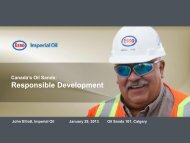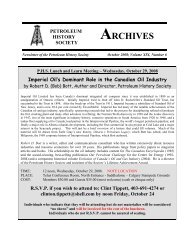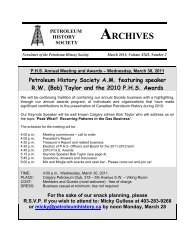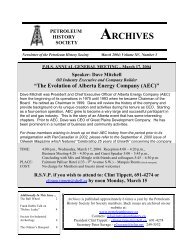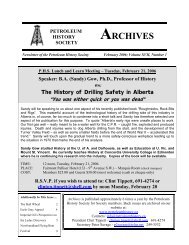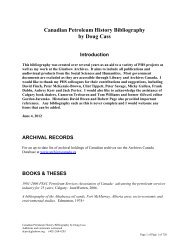PDF format - Petroleum History Society
PDF format - Petroleum History Society
PDF format - Petroleum History Society
Create successful ePaper yourself
Turn your PDF publications into a flip-book with our unique Google optimized e-Paper software.
PETROLEUM<br />
HISTORY<br />
SOCIETY<br />
ARCHIVES<br />
Newsletter of the <strong>Petroleum</strong> <strong>History</strong> <strong>Society</strong> February 2003; Volume XIV, Number 1<br />
LUNCH AND LEARN and ANNUAL AWARDS MEETING<br />
Noon, Wed., February 12, 2003, Fairmont Palliser Hotel, Leduc Room (Mezzanine Level)<br />
Speakers: Kirsten Olson and Myrene Hayes<br />
THE ORAL HISTORY PROJECT OF THE<br />
LEGAL ARCHIVES SOCIETY OF ALBERTA<br />
Kirsten Olson will discuss the background of the LASA Oral <strong>History</strong> Program – from initial interviews<br />
commissioned by the Calgary Bar Association to the expansion of the program throughout the<br />
province. This will include funding, management, possible pitfalls, historical significance of records<br />
(anecdotal vs. hard research) and legal responsibilities. Myrene Hayes will discuss how the Calgary<br />
program works: advisory committee, background research, pre-interviews, transcribing and editing. A<br />
brief sample of one of the interviews will be shown on video. This should be an interesting<br />
comparison to the PHS Oral <strong>History</strong> Project. Maybe we’ll see how a lawyer conducts an interview!<br />
Kirsten Olson started working with the LASA in 1996 and has been the Executive Director since 1998. She oversees the<br />
<strong>Society</strong>’s many province-wide programs including publications, research services and oral histories. Myrene Hayes was<br />
hired on contract by the <strong>Society</strong> in 2002 to revive the Oral <strong>History</strong> Project in Calgary. She has succeeded in streamlining<br />
the process for the interviews from managing the committee (all lawyers) to doing background research, conducting<br />
interviews and editing transcripts<br />
TIME: Noon (receipts at the door), February 12, 2003.<br />
PLACE: Fairmont Palliser Hotel (133 - 9 th Avenue S.E.) – Leduc Room (check marquee on arrival).<br />
COST: $25 Members and $30 Guests (most welcomed)<br />
R.S.V.P. Clint Tippett, 691-4274 or clinton.tippett@shell.ca<br />
by noon Monday, February 10<br />
Additionally In This Issue ...<br />
The Bull Wheel 2<br />
P.H.S. 2001 Awards 5<br />
David Finch Talk – Nov. 13 6<br />
Stan Pearson Talk – Dec. 11 7<br />
if you missed the last luncheon talks…<br />
AN EAR ON HISTORY – THE PETROLEUM INDUSTRY ORAL HISTORY<br />
PROJECT<br />
Wednesday, November 13, 2002 by David Finch, Author<br />
and<br />
A LIFELONG CAREER WITH GULF<br />
Wednesday, December 11, 2002 by Stan Pearson, Explorer<br />
...enjoy condensed versions of these presentations in this issue of Achives
THE PETROLEUM HISTORY SOCIETY<br />
THE BULL WHEEL<br />
March Annual General Meeting: Following this month’s talk, our next gathering<br />
will be our Annual General Meeting and elections that will take place on<br />
Wednesday, March 19, 2003 in the Canadian Pacific Room of the Fairmont-<br />
Palliser. We have been fortunate enough to have been able to arrange for John<br />
Ballem to be our meeting speaker. John is well known to many of you both as an<br />
oil and gas lawyer of local prominence and as the author of a series of novels<br />
that are often based upon intrigues in the oilpatch. John will be speaking to us<br />
on a wide range of reminiscences based upon his many years of experience.<br />
<strong>Society</strong> E-Mail Address: All members with e-mail service who have not<br />
already done so, please send in your address to Micky Gulless, Past President,<br />
Membership Committee at her address “micky@fuzzylogic.ca”.<br />
Membership: Please consult your mailing label for the status of your<br />
membership. Renewal notices have been included with this February issue for<br />
those whose memberships are due. Thanks to Micky for her continuing hard<br />
work in maintaining our records!<br />
P.H.S. Website Update: Website coordinator Micky Gulless is continually<br />
updating the <strong>Society</strong> website at http://www.petroleumhistory.ca Tune in from time to<br />
time and see what new features and links have been highlighted!<br />
Canadian <strong>Petroleum</strong> Hall of Fame Special: For the interest of our members,<br />
here is a bit of additional background on Eugene Coste who was recently<br />
inducted into the Hall following his nomination by our <strong>Society</strong>. As Aubrey Kerr<br />
says, “now the true story can be told”!: “Eugene joined the Geological Survey of<br />
Canada, but left after five years to explore for oil and gas on his own, convinced<br />
that oil originated from “volcanic” or Precambrian rocks. Eugene hung<br />
tenaciously all his life to his mistaken theory about the volcanic origin of<br />
petroleum and natural gas, but that did not stop him from making the discoveries<br />
that laid the foundation for Ontario’s [and Alberta’s] natural gas industry. …The<br />
Coste interests organized the Volcanic Oil and Gas Co. in 1906..”<br />
The Prize: This prize-winning television series, based on the book by the same<br />
name by author Daniel Yurgin, is being broadcast on the <strong>History</strong> Channel starting<br />
on Sunday, February 2. Hopefully you can catch the end of the series at least.<br />
<strong>Petroleum</strong> <strong>History</strong> <strong>Society</strong> Archives: February 2003; Volume XIV, Number 1 Page 2
Bad Boy made Good?: It was recently announced that W. Edmund Clark has been named as<br />
President and Chief Executive Officer of the TD Bank Financial Group. You remember Ed. He<br />
was a senior mandarin in Pierre Trudeau’s Liberal Government at the time that the National<br />
Energy Program was introduced in 1980. It was his doctoral thesis on “Public Investment and<br />
Socialist Development in Tanzania” that is alleged to have served as a model for that highly<br />
intervenionist package of policies.<br />
“Canmore Miners” Book Released: Lawrence Chrismas has produced this book, subtitled<br />
“Coal Miner Portraits and Stories”, through Cambria Publishing (Box 61083, Kensington PO,<br />
Calgary, Alberta, T2N 4S6) for the Canmore Centennial Museum <strong>Society</strong>. It was sponsored by<br />
Canmore individuals, families, businesses and the Town of Canmore. It is dedicated to the “saltof-the-earth<br />
people: Canmore miners and their families”. The publication is soft covered and has<br />
numerous glossy page sized photos over its 64 9” by 12” black and white pages. This high<br />
quality publication sells for $24.95 plus shipping and GST. It combines a tradition of excellent<br />
portrait photo documentation with oral history.<br />
Turner Valley Revival: Two items have recently appeared in the press to indicate a revival at<br />
Turner Valley. The first is the reconstruction of the Dingman No. 1 historical derrick in the centre<br />
of town. The earlier 10m version was blown down in a windstorm last winter. The new one cost<br />
about $28,000 with the funds coming from a combination of donations and insurance. This<br />
included a $5000 gift from Talisman who now operate the production units on the south end of<br />
the field – a legacy of their purchase of Western Decalta. Talisman is also “pumping” the region<br />
with a nitrogen injection scheme announced in December that is intended to boost the recovery of<br />
oil from the Mississippian reservoir. The three year pilot could lead to a full scale $150 million<br />
project if encouraging results are obtained.<br />
Another Cable Tool Rig!: The Leduc/Devon Historical <strong>Society</strong> has announced in their “Catwalk”<br />
newsletter that a cable tool rig has been constructed at their Devon, Alberta location. As they<br />
stated ”Our volunteers continue to amaze us! If you have driven by the site lately, you will have<br />
noticed a new addition to our skyline. Dwarfed by its modern family, our cable tool derrick was<br />
raised on September 10, 2002. Built by volunteer members, using a 1923 Oil Well Supply<br />
catalogue and the expertise of Garnet Edwards, the cable tool rig took all summer to complete<br />
and now provides an attractive addition to the Leduc #1 Historical Site and to the story of oil<br />
discovery and production in Canada”.<br />
Growing Interest in <strong>History</strong>: Items appearing in the press concerning the heightened level of<br />
public interest in things historical. Oct. 29, 2002: “Most want Canadian <strong>History</strong> as Required<br />
Course in High School” and Dec. 5, 2002: “Record attendance at Historic Sites, Museums”.<br />
Hopefully our <strong>Society</strong> can play a role in this emerging trend.<br />
<strong>Petroleum</strong> Stamp: On Sept. 14, 2002, the U.S. issued a new 37 cent stamp honouring Ida M.<br />
Tarbell (1857-1944) as a part of a series commemorating Women in Journalism. You will recall<br />
that Ms. Tarbell published a book entitled “The <strong>History</strong> of the Standard Oil Company”. It was<br />
described as “a powerful expose of the Standard Oil Company in its attempts to monopolize the<br />
oil industry in the late 19 th and early 20 th centuries [which] led to Congress passing antitrust<br />
legislation that dismantled the company. Her journalistic style came to be known as muckraking”.<br />
Ida, where are you when we need you for ExxonMobil?<br />
New Book: Sheridan, D., 2000. Fahud, The Leopard Mountain, Oil Exploration in Oman and<br />
Libya in the 1950’s. Published by Vico Press, Dublin, 256 p., 24.95 pounds (that’s price, not<br />
weight).<br />
<strong>Petroleum</strong> <strong>History</strong> <strong>Society</strong> Archives, February 2003, Volume XIV, Number 1 Page 3
Volunteers needed!: The <strong>Petroleum</strong> <strong>History</strong> <strong>Society</strong> depends on its members to support its<br />
activities – whether by taking the initiative on a project, volunteering to staff a booth at a<br />
function or serving on the Board as a Director or member of the Executive. If you have an<br />
interest in getting more involved and helping out, we’d like to hear from you – so please call<br />
Clint Tippett at 691-4274 and let’s make it happen. Elections coming soon!<br />
Why Value <strong>History</strong>? (and what you can do about it): A recent article from EOS (The<br />
Transactions of the American Geophysical Union) reviewed the issues around why history is<br />
important and what you can do to ensure that it is preserved. The following five (adapted)<br />
suggestions were made: 1. Trust that future generations will want to know about your work,<br />
your contributions, your ideas. 2. If you have correspondence, notebooks, reports,<br />
photographs and snapshots – what historians call “papers” – contact the archivist at your<br />
company or organization to discuss donating them to an appropriate repository [The<br />
Glenbow?]. 3. Do not “weed” your papers in advance. Archives are willing to place access<br />
restrictions on sensitive materials. 4. If a historian requests an oral history interview with<br />
you, accept this opportunity. Interviews are an invaluable means of capturing a person’s life<br />
story and experiences. 5. Consider writing a manuscript autobiography for deposit in the<br />
archives. Or write a historical account of your company or organization. Picking up a pen (or<br />
turning on your word processor) is the best way to start.<br />
Museum and Heritage Studies at the University of Calgary: Don Wetherell was recently<br />
hired by the U. of C. to teach museum and heritage studies In the program, students<br />
combine museum studies with another subject such as … history. Teaching methods that<br />
combine theory with practical projects are used and all students must complete a practicum<br />
at a museum, historic site or other cultural heritage facility.<br />
Japanese Approach to <strong>History</strong>: National Geographic reported that one approach used in<br />
Japan to preserve historical practices is to employ individuals to learn old techniques, to<br />
actively use and reenact them, and to pass them down to future candidates for their<br />
positions. The above mentioned construction of a cable tool rig in Devon is the closest I’ve<br />
seen to this although Tom Wark’s instructions on the Heritage Park rig would be close.<br />
Fun Items: Recently spotted:<br />
1. Looking on the bright side. In the summer of 1996 the Saguenay/Chicoutimi region of<br />
Quebec was ravaged by floods from heavy rains and burst dams. Geologists, however, saw<br />
a bright side – “… the geological community here has an incredible series of newly stripped<br />
outcrops to examine…”.<br />
2. “Parisian prankster plays with history”: Apparently the abundance of historical<br />
plaques in Paris was too much for some and they have fought back One prominent “antiplaque”<br />
says (in French): “On April 17, 1967, nothing happened here”.<br />
3. Global Warming has affected some people’s brains: An article in the Calgary Herald<br />
of May 17, 2002, carried from the Associated Press in Washington D.C., was headlined<br />
“April’s warmth makes record book – temperature in U.S. 16 degrees above average”. This<br />
is repeated in the text so it wasn’t just a typo. Get a grip – 16 degrees?<br />
4. Getting Bombed: Some of you may recall the wish of General Curtis LeMay to bomb<br />
North Vietnam back into the Stone Age during the Vietnam War. Ric Dolphin of the Calgary<br />
Herald has done him one better by speculating about bombing Iraq back into the Pleistocene,<br />
calling this the Pleistocene Option! Would this be an attack by stealth glaciers?<br />
<strong>Petroleum</strong> <strong>History</strong> <strong>Society</strong> Archives: February 2003; Volume XIV, Number 1 Page 4
2001 PETROLEUM HISTORY SOCIETY AWARDS<br />
The P.H.S. is pleased to announce the winners of the 2001 awards process. The<br />
recipients have been invited to the February 12 luncheon and will be presented with<br />
their plaques at that time. Those winners are:<br />
Book of the Year for 2001:<br />
To Frank Dabbs, for “Branded by the Wind – The Life and Times of Bill Herron”,<br />
published by Marjorie A. Herron and printed by Tri.Ad Press. This book describes the<br />
life of Bill Herron Jr. in the context of both the oilpatch legacy of his father (Bill Herron,<br />
Sr. who was one of the early promoters of the Turner Valley structure) and his own<br />
accomplishments in both the oil industry and ranching.<br />
Article of the Year for 2001:<br />
To Arn Keeling, for “The Rancher and the Regulators: Public Challenges to Sour Gas<br />
Industry Regulation in Alberta, 1970-1994”, published in “Writing off the Rural West:<br />
Globalization, Governments and the Trans<strong>format</strong>ion of Rural Communities”, Epp, R.<br />
and Whitson, D. (eds.), University of Alberta Press.<br />
Preservation Award for 2001:<br />
To Evelyn DeMille, owner of DeMille Technical Bookstore, for her long term support<br />
for publications dealing with the history of the Canadian and international oil industries.<br />
She supported the self-published works of Aubrey Kerr and others and was always the<br />
most reliable shop for this type of literature. (DeMille Technical Bookstore is now part<br />
of the new McNally Robinson Booksellers outlet on the Stephen Avenue Walk.)<br />
Multimedia Award for 2001:<br />
To the <strong>Petroleum</strong> Communications Foundation, for its many excellent publications<br />
intended for public in<strong>format</strong>ion and education about the industry. These books and<br />
brochures have included such classics as “Our <strong>Petroleum</strong> Challenge”, issued in<br />
multiple editions. The historical aspects of the Canadian oil and gas business have<br />
always played a role in these works with the activities and accomplishments of our<br />
predecessors setting the stage for the more recent events and improved technologies.<br />
Lifetime Achievement Award for 2001:<br />
The Executive and Board have elected to forego making this award for 2001.<br />
The P.H.S. initiated this series of awards a number of years ago with the intention of<br />
recognizing those individuals and organizations who have made significant individual<br />
and life long contributions to various aspects of the preservation, study and<br />
dissemination of Canadian <strong>Petroleum</strong> <strong>History</strong>. Please forward your suggestions for<br />
the 2002 cycle to either Clint Tippett (Shell Canada) or Doug Cass (Glenbow).<br />
___________________________________________________________________________________________________________________<br />
<strong>Petroleum</strong> <strong>History</strong> <strong>Society</strong> Archives: February 2003; Volume XIV, Number 1 Page 5
<strong>Petroleum</strong> <strong>History</strong> <strong>Society</strong> Luncheon<br />
November 13, 2002<br />
David Finch - Author<br />
“An Ear on <strong>History</strong> – The <strong>Petroleum</strong> Industry Oral <strong>History</strong> Project”<br />
David Finch is a long time member of our <strong>Society</strong> and is a recipient of our Lifetime Achievement<br />
Award (although he has lots of time to earn a repeat on this one). David is also the lead<br />
interviewer for the PIOHP and as such works closely with PHS Secretary Peter Savage and<br />
Treasurer Doug Cass. To top it off, David is also one of the key users of the historical resource<br />
that is generated by the PIOHP in that he is the author of numerous books and articles related to<br />
the multiple facets of the oilpatch. Many look to David as a key player in this sector of historical<br />
studies. It is in this context that we invited David to speak to us about the current state of the<br />
PIOHP and to reveal any interesting insights that he may have gained along the way.<br />
The presentation began with some historical background. The PIOHP was the brainchild of PHS<br />
Director Aubrey Kerr who began a series of interviews in the early 1980’s. Aubrey wished that<br />
the initiative would continue and that a suitable repository for the results could be found that<br />
would allow access by future researchers. Following a period of fundraising, approx. 250<br />
interviews were completed. In 1999 a second phase of the project began with new interviews<br />
and completion of transcription of the tapes from both phases. It is anticipated that about 100<br />
more interviews will be completed. This phase was largely funded by contributions from groups<br />
like the Canadian <strong>Society</strong> of <strong>Petroleum</strong> Geologists and through Provincial Government grants.<br />
David then spent some time describing how the transcripts of these interviews are used. Some<br />
are educational. The effects of industry booms and busts on companies and individuals are<br />
studied – how both coped (or didn’t) provides valuable perspectives for current events.<br />
Technological evolution is another aspect of the industry that can be examined with these<br />
records. Operations in new areas and under difficult conditions led to the invention of new<br />
equipment. Horses and canoes (the latter regretfully) were followed by trucks and outboards.<br />
Long traverses were made obsolete by the use of fixed wing aircraft and helicopters. Drilling in<br />
ice-infested waters was made possible through the invention of artificial islands and drilling<br />
platforms. The people being interviewed were often the ones most intimately acquainted with<br />
these changes and the impacts that they had on the industry.<br />
David could not resist recounting some of the more humourous stories that he had heard in his<br />
interviewing. One story had to do with how Harold Farney came to Canada as a result of an<br />
overheard conversation. Another by this same individual related making a “deadstick” landing in<br />
winter on the frozen Athabasca River. PHS Secretary Peter Savage had told of pervasive<br />
constipation amongst his seismic crew due to a combination of minus 60 degree weather and an<br />
unheated latrine. And also about part of a crew being saved from starvation by the generosity of<br />
a local Indian band.<br />
David’s descriptive section closed off with a summary of some of the more controversial issues<br />
that he had run across in the interviews. These included the publication of a book by the CSPG<br />
deemed to be unacceptable due to its treatment of evolution (1970). Both companies and<br />
individuals have generally been reluctant to engage directly in political or regulatory matters but<br />
submissions related to the direction of the industry, such as the Dinning Commission of 1949 on<br />
gas reserves and the House of Commons Committee on future hydrocarbon potential in 1973<br />
seemed fair game. Issues like the National Energy Program, the renaming of Mount Logan and<br />
the ratification of the Kyoto Accord have all triggered public stances within the industry.<br />
The session closed off with an outlook for the project and a call for additional funds (of course!).<br />
<strong>Petroleum</strong> <strong>History</strong> <strong>Society</strong> Archives, February 2003, Volume XIV, Number 1 Page 6
<strong>Petroleum</strong> <strong>History</strong> <strong>Society</strong> Luncheon<br />
December 11, 2002<br />
Stan Pearson – Explorer<br />
“A Lifelong Career with Gulf”<br />
Stan Pearson talked to us in mid-December on this topic that is obviously near and dear to his<br />
heart. As we discovered only after the presentation, the lack of reading notes did nothing to<br />
hamper his recollection of details from virtually every stage of his life.<br />
Stan would be an anomaly these days as he spent virtually his entire career with one company.<br />
That’s how it was done “in those days”. As Stan told it he was a plumber’s son from Pincher<br />
Creek who was educated at the U. of Alberta, who served his time in the Canadian Forces in<br />
WWII, who married his sweetheart in Brandon and who was diverted from his Waterton<br />
honeymoon by an opening on a Canadian Gulf seismic crew in Pincher Creek. Gulf was a<br />
pioneer in the application of geophysical technologies in Canada having tried gravity, having<br />
experimented with seismic at Turner Valley in 1943-44 and having perfected the application of<br />
refraction along the Foothills Belt. The last mentioned led to the discovery of the Pincher Creek<br />
Field in 1947 where high rates and subsequent seismic mapping indicated the presence of huge<br />
reserves (on the order of 3 TCF). These were later to serve as the springboard for the exportrelated<br />
TransCanada pipeline in 1957. Unfortunately, according to Stan, these were “constipated<br />
rocks” that drew up water along fractures when the field was brought into production – or as<br />
Aubrey saw it – “exploration success but flawed exploitation”.<br />
In the late 1940’s and early 1950’s Stan was active in the central Alberta region where<br />
discoveries were made at Buffalo Lake-Drumheller, Fenn West, Westerose and Rimbey. 1949<br />
was a record year for seismic acquisition for Stan and Co. in Gulf’s “Gypsy Division”. This was<br />
followed by a spell in the Cadotte River area where attempts to work in muskeg required the<br />
invention of new equipment.<br />
By 1954 Stan was Exploration Manager in Calgary and was instrumental in Gulf’s successful<br />
programs in the Swan Hills region (1950’s and 1960’s) and the Zama region (1960’s). At this<br />
point Gulf began to look north and in the 1956-1957 period “blitzed” the western Northwest<br />
Territories and Yukon. In 1957, following a meeting in New Orleans where a euphoric mindset on<br />
deltas was present, a decision was made to secure acreage in the Mackenzie Delta. According<br />
to Stan, two million acres were relinquished from the three million onshore acres originally taken<br />
up and these lands were subsequently acquired by Shell and Imperial. Gulf also filed on<br />
significant acreage in the Beaufort. Both fairways bore fruit for Gulf with the onshore Parsons<br />
Lake Gas Field and the offshore Amauligak Oil and Gas Field.<br />
1968 found Stan based in London and in charge of Eastern Hemisphere exploration where again<br />
success soon followed with the acquisition of lands in the Brent trend on the U.K sector and in the<br />
Dan Field on the Norwegian side. Other successful campaigns were conducted in the offshore<br />
parts of the Niger and Congo River deltas of West Africa.<br />
By 1977 Stan was back in Toronto as Senior V.P. He retired in 1979. He judged his career at<br />
Gulf to have been highly successful – and who would argue? He leads a bucolic existence on a<br />
farm near Cremona (from which hay is exported to Japan) and in Calgary.<br />
Photographs on the back page:<br />
Clockwise from the upper left.<br />
1. Wooden cable tool rig in the Flathead Valley.<br />
2. Steel rig on the discovery well at Leduc (1947).<br />
3. Making a connection on a rotary rig with a spinning chain.<br />
4. The bull wheel on an early cable tool rig.<br />
<strong>Petroleum</strong> <strong>History</strong> <strong>Society</strong> Archives, February 2003, Volume XIV, Number 1 Page 7
Please see page 7 for captions. Thanks.<br />
<strong>Petroleum</strong> <strong>History</strong> <strong>Society</strong> Archives, February 2003, Volume XIV, Number 1 Page 8



